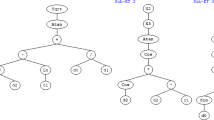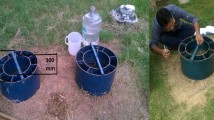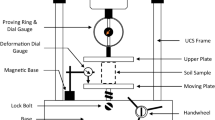Abstract
In this study, the soft computing technique of Gene expression programming (GEP) has been employed to generate a predictive equation of infiltration rate (fp). Infiltration experiments were conducted at 124 different sites and soil samples were collected to assess various soil properties throughout the Himalayan lake catchment. Parameters determined from observed data using nonlinear-Levenberg Marquardt algorithm were substituted in Horton, Kostiakov and Philip infiltration models and fp were predicted. Using soil data generated by laboratory investigation of soil samples, the GEP model was developed. Training and testing of the GEP model was performed using 70% and 30% of data respectively. Performance of GEP developed functional relationship was evaluated by comparing predictions from it and aforementioned infiltration models with field observed fp, and by applying overall performance index (OPI) computed using Coefficient of Determination (R2), Nash–Sutcliffe Efficiency (ENS), Willmott’s Index of Agreement (W), Mean Absolute Error (MAE) and Root Mean Square Error (RMSE). Expression developed using GEP indicated feasibility of developed equation with ENS, R2, W, RMSE and MAE of 0.84, 0.84, 0.96, 1.9, and 0.8, respectively for training data-set and 0.84, 0.85, 0.95, 1.2, and 0.95, respectively for testing data-set. Comparative analysis revealed that though with a slightly higher OPI value (0.7–0.8), the performance of conventional models is better compared to the GEP model (0.66) but the GEP model having satisfactory performance may be used for fp prediction particularly in absence of observed data.






Similar content being viewed by others
Data Availability
The data being part of PhD research work can’t be shared at this stage but will be available upon request to the corresponding author.
References
Ali S, Islam A, Mishra PK, Sikka AK (2016) Green-Ampt approximations: A comprehensive analysis. J Hydrol 535:340–355. https://doi.org/10.1016/j.jhydrol.2016.01.065
Azamathulla HM, Ghani AA, Leow CS et al (2011) Gene-expression programming for the development of a stage-discharge curve of the Pahang River. Water Resour Manag 25(11):2901–2916. https://doi.org/10.1007/s11269-011-9845-7
Badar B, Romshoo SA, Khan MA (2013) Integrating biophysical and socioeconomic information for prioritizing watersheds in a Kashmir Himalayan lake: a remote sensing and GIS approach. Environ Monit Assess 185(8):6419–6445
Blacke GR, Hartge KH (1986) Bulk density in Klute A (ed) Methods of Soil Analysis, Part 1: Physical and Mineralogical Methods, Soil Science Society of America, Madison, WI, pp 363–375
Dashtaki SG, Homaee M, Mahdian MH, Kouchakzadeh M (2009) Site-dependence performance of infiltration models. Water Resour Manag 23(13):2777–2790
Deep K, Das KN (2008) Optimization of infiltration parameters in hydrology. World Journal of Modelling and Simulation 4:120–130
Duan R, Fedler CB, Borrelli J (2011) Field evaluation of infiltration models in lawn soils. Irrigation Sci 29:379–389. https://doi.org/10.1007/s00271-010-0248-y
Ferreira C (2001a) Gene expression programming in problem solving. In: 6th Online World Conference on Soft Computing in Industrial Applications (Invited Tutorial)
Ferreira C (2001b) Gene expression programming: a new adaptive algorithm for solving problems. Complex System 13:87–129
Ferreira C (2002) Gene Expression Programming in Problem Solving. In: Roy R, Köppen M, Ovaska S, Furuhashi T, Hoffmann F (ed) Soft Computing and Industry. Springer, London
Gee GW, Bauder JW (1986) Particle-size analysis in Klute A (ed) Methods of soil analysis, Part1: Physical and Mineralogical Method, Soil Science Society of America, Madison, WI, pp 383–412
Green WH, Ampt GA (1911) Studies on Soil Physics. J Agric Sci 4:1–24. https://doi.org/10.1017/S0021859600001441
Guven A, Aytek A, Yuce MI, Aksoy H (2008) Genetic programming based empirical model for daily reference evapotranspiration estimation. Clean-Soil Air Water 36(10–11):905–912
Guven A, Aytek A (2009) New approach for stage–discharge relationship: gene-expression programming. J Hydrolog Eng 14(8):812–820
Guven A, Kisi Ö (2010) Daily pan evaporation modeling using linear genetic programming technique. Irrigat Sci 29(2):135–145
Guven A, Kisi Ö (2011) Estimation of suspended sediment yield in natural rivers using machine-coded linear genetic programming. Water Resour Manag 25:691–704
Holtan HN (1961) Concept for infiltration estimates in watershed engineering ARS 41–51. U S Department of Agriculture, Agricultural research service, Washington, DC
Horton RE (1941) An approach toward a physical interpretation of infiltration-capacity 1. Soil Sci Soc Am J 5:399–417. https://doi.org/10.2136/sssaj1941.036159950005000C0075x
Kale RV, Sahoo B (2011) Green-Ampt infiltration models for varied field conditions: A revisit. Water Resour Manag 25(14): 3505–3536. https://doi.org/10.1007/s11269-011-9868-0
Kostiakov AN (1932) On the dynamics of the coefficient of water-percolation in soils and on the necessity for studying it from a dynamic point of view for purposes of amelioration. Society of Soil Science 14:17–21
Kalogirou SA (2001) Artificial neural networks in the renewable energy systems applications: a review. Renew Sustain Energy Rev 5:373–401
Khan M, Azamathulla H M, Tufail, M, Ab Ghani A (2012) Bridge pier scour prediction by gene expression programming. In Proceedings of the Institution of Civil Engineers-Water Management 165(9):481–493. https://doi.org/10.1680/wama.11.00008
Legates DR, McCabe GJ (1999) Evaluating the use of ‘‘goodness-of-fit” measures in hydrologic and hydroclimatic model validation. Water Resour Res 35(1):233–241
Ma D, Shao M (2008) Simulating infiltration into stony soils with a dual-porosity model. Eur J of Soil Sci 59:950–959
Machiwal D, Jha MK, Mal BC (2006) Modelling infiltration and quantifying spatial soil variability in a wasteland of Kharagpur, India. Biosyst Eng 95:569–582. https://doi.org/10.1016/j.biosystemseng.2006.08.007
Marquardt DW (1963) An algorithm for least-squares estimation of nonlinear parameters. J Soc Ind App Math 11:431–441. https://doi.org/10.1137/0111030
Mazloom H, Foladmand H (2013) Evaluation and determination of the coefficients of infiltration models in Marvdasht region, Fars province. Int J Adv Biol Biomed Res 1:822–829
Mishra SK, Tyagi JV, Singh VP (2003) Comparison of infiltration models Hydrol Processs 17:2629–2652. https://doi.org/10.1002/hyp.1257
Mirzaee S, Zolfaghari AA, Gorji M, Dyck M, Dashtaki SG (2013) Evaluation of infiltration models with different numbers of fitting parameters in different soil texture classes. Arch Agron Soil Sci 60(5):1–13. https://doi.org/10.1080/03650340.2013.823477
Moriasi DN, Arnold JG, Van Liew MW, Bingner RL et al (2007) Model evaluation guidelines for systematic quantification of accuracy in watershed simulations. Trans ASABE 50(3):885–900
Muzzammil M, Alama J, Danish M (2015) Scour prediction at bridge piers in cohesive bed using gene expression programming. Aquat Procedia 4:789–796. https://doi.org/10.1016/j.aqpro.2015.02.098
Oyedele O, Akpa EA, Akpan JF (2019) Evaluation of Infiltration Characteristics of Soils Developed on Coastal Plain Sands in Calabar Municipality Local Government Area, Cross River State, Nigeria’. Asian Journal of Advances in Agricultural Research 10:1–8. https://doi.org/10.9734/ajaar/2019/v10i430036
Parhi PK, Mishra SK, Singh R (2007) A modification to Kostiakov and Modified Kostiakov infiltration models. Water Resour Manag 21:1973–1989
Philip JR (1957) The theory of infiltration: 1 the infiltration equation and its solution. Soil Sci 83: 345–357. https://doi.org/10.1097/00010694-200606001-00009
Rao MD, Raghuwanshi NS, Singh R (2006) Development of a physically based 1D-infiltration model for seal formed irrigated soils. Agric Water Manage 84(1–2):164–174
Rasool T, Dar AQ, Wani MA (2020) Comparison of infiltration model parameter estimation techniques under different land use/land covers International journal of Hydrology sciences and Technology (in press)
Richard LA (1931) Capillary conduction of liquids through porous mediums. Physics 1:318–333. https://doi.org/10.1063/1.1745010
Saxton KE, Willey PH (2006) The SPAW model for agricultural field and pond hydrologic simulation. Watershed models, 401–435
Shao Q, Baumgartl T (2014) Estimating input parameters for four infiltration models from basic soil, vegetation, and rainfall properties. Soil Sci Soc Am J 78:1507–1521. https://doi.org/10.2136/sssaj2014.04.0122
Skaggs RW, Khaleel R (1982) Chapter 4: Infiltration. In Haan CT (ed) Hydrologic Modeling of Small Watersheds. Am Soc Agric Eng pp 119–166
Smith RE (1972) The infiltration envelope: results from a theoretical infiltrometer. J Hydrol 17:1–22. https://doi.org/10.1016/0022-1694(72)90063-7
Smith RE, Parlange JY (1978) A parameter-efficient hydrologic infiltration model. Water Resour Res 14:533–538. https://doi.org/10.1029/WR014i003p00533
Soil Survey Division Staff (1993) Soil survey manual. Soil Conservation Service. United States Department of Agriculture Handbook, vol. 18. USDA, Washington, DC
Seyedzadeh A, Panahi A, Maroufpoor E (2020) A new analytical method for derivation of infiltration parameters. Irrig Sci 38:449–460
Sihag P, Singh B, Sepah Vand A, Mehdipour V (2018) Modeling the infiltration process with soft computing techniques. ISH J Hydraul Eng 26(2):138–152. https://doi.org/10.1080/09715010.2018.1464408
SPSS (2011) Statistical package for social sciences. Release 20.0. SPSS Inc, Chicago Il
Tabbussum R, Dar AQ (2021) Performance evaluation of artificial intelligence paradigms—artificial neural networks, fuzzy logic, and adaptive neuro-fuzzy inference system for flood prediction. Environ Sci Pollut Res 1-18. https://doi.org/10.1007/s11356-021-12410-1
Traore S, Guven A (2012) Regional-specific numerical models of evapotranspiration using gene-expression programming interface in Sahel. Water Resour Manag 26(15):4367–4380
Traore S, Luo Y, Fipps G (2017) Gene-expression programming for short-term forecasting of daily reference evapotranspiration using public weather forecast information. Water Resour Manag 31(15):4891–4908
Walkley A, Black IA (1934) An examination of the Degtjareff method for determining soil organic matter and a proposed modification of the chromic acid titration method. Soil Sci 37(1):29–38
Yassin MA, Alazba AA, Mattar MA (2016) A new predictive model for furrow irrigation infiltration using gene expression programming. Comput Electron Agric 122:168–175. https://doi.org/10.1016/j.compag.2016.01.035
Acknowledgements
The authors are grateful to the Head of Department, Civil Engineering, National Institute of Technology Srinagar for providing adequate laboratory facilities.
Funding
The authors would like to thank the Ministry of Human Resources and Development, India for funding the research.
Author information
Authors and Affiliations
Contributions
Tabasum Rasool designed the study, obtained the data and prepared it for simulation and statistical analysis, and wrote the first draft of manuscript, and is the guarantor. Author Abdul Qayoom Dar managed the literature searches. Author Mushtaq Ahmad Wani contributed to the preparation of the final manuscript.
Corresponding author
Ethics declarations
Conflict of Interest/ Competing Interest
The authors declare that they do not have any conflict of interest to disclose.
Additional information
Publisher's Note
Springer Nature remains neutral with regard to jurisdictional claims in published maps and institutional affiliations.
Rights and permissions
About this article
Cite this article
Rasool, T., Dar, A.Q. & Wani, M.A. Development of a Predictive Equation for Modelling the Infiltration Process Using Gene Expression Programming. Water Resour Manage 35, 1871–1888 (2021). https://doi.org/10.1007/s11269-021-02816-4
Received:
Accepted:
Published:
Issue Date:
DOI: https://doi.org/10.1007/s11269-021-02816-4




